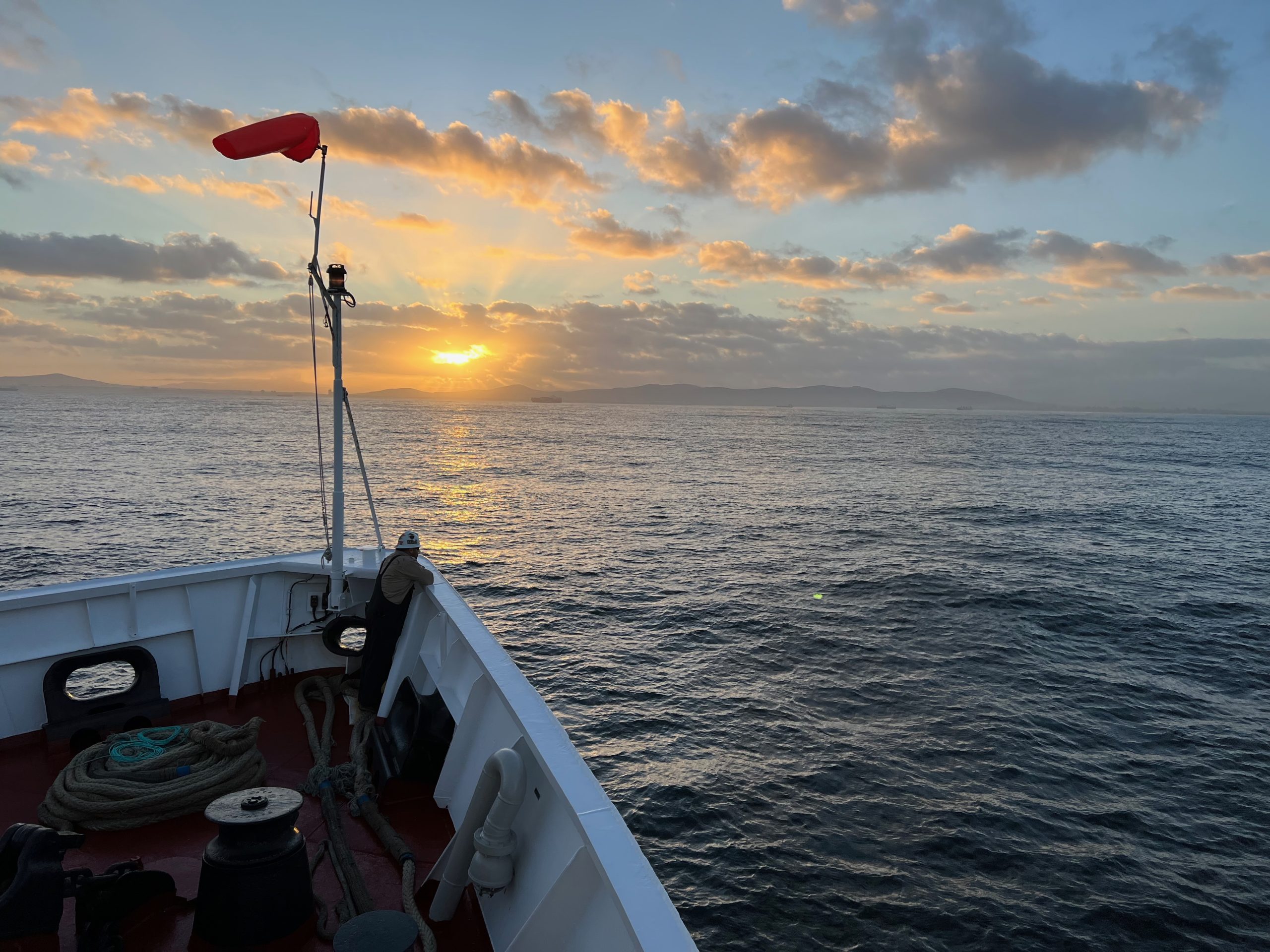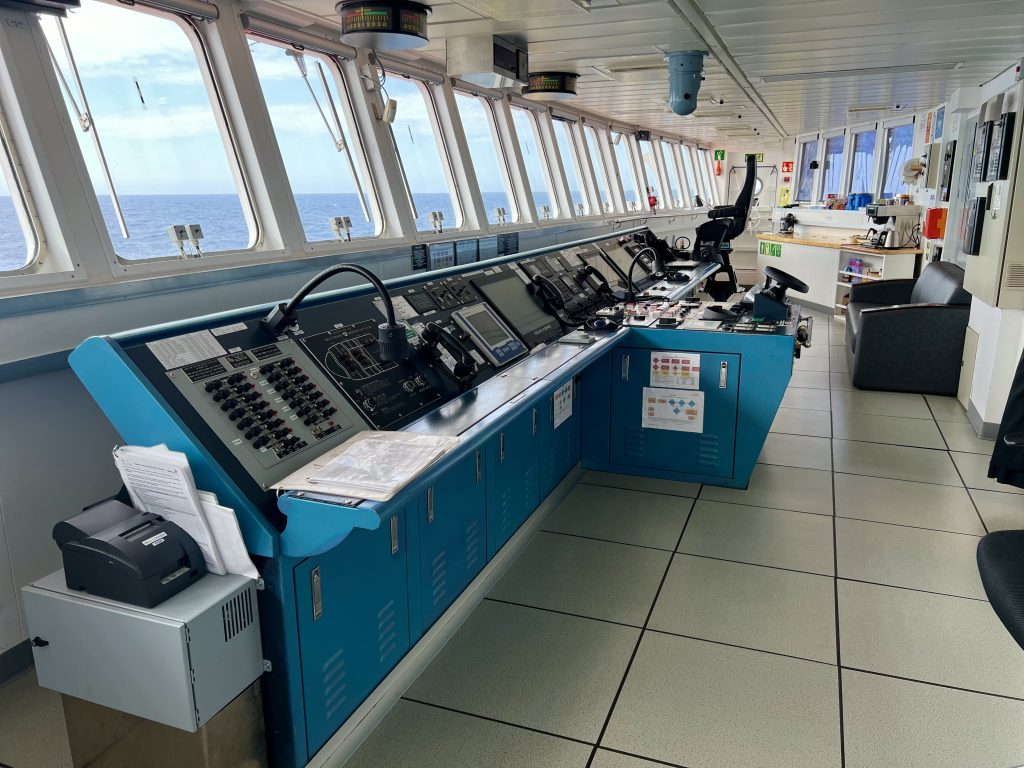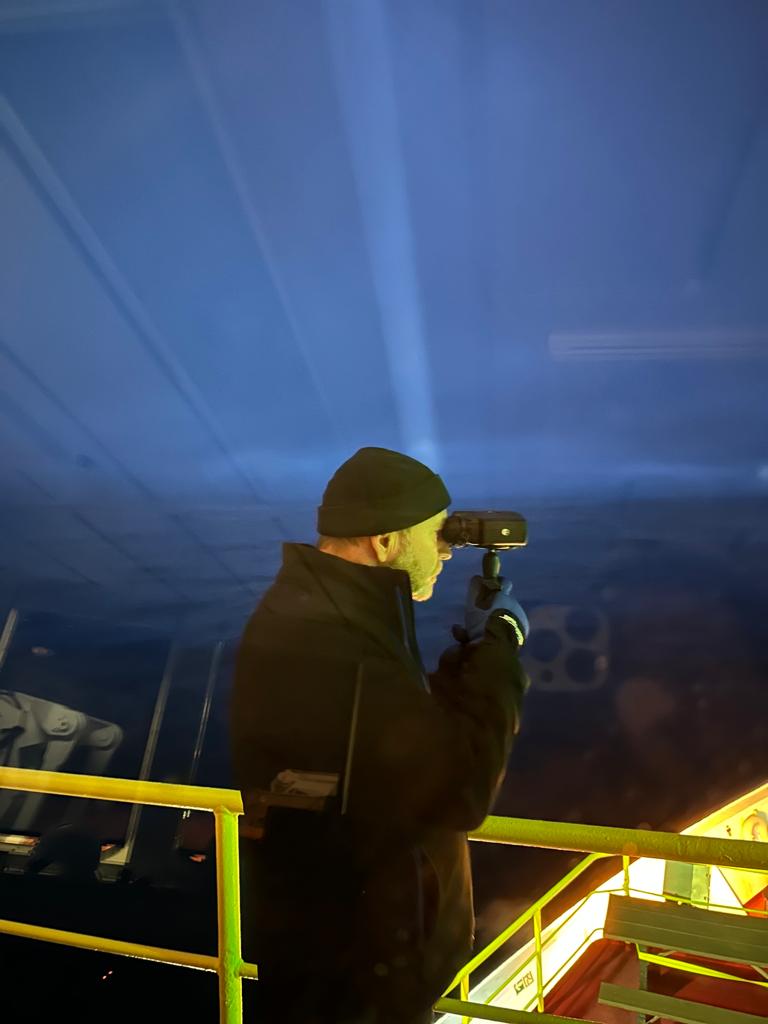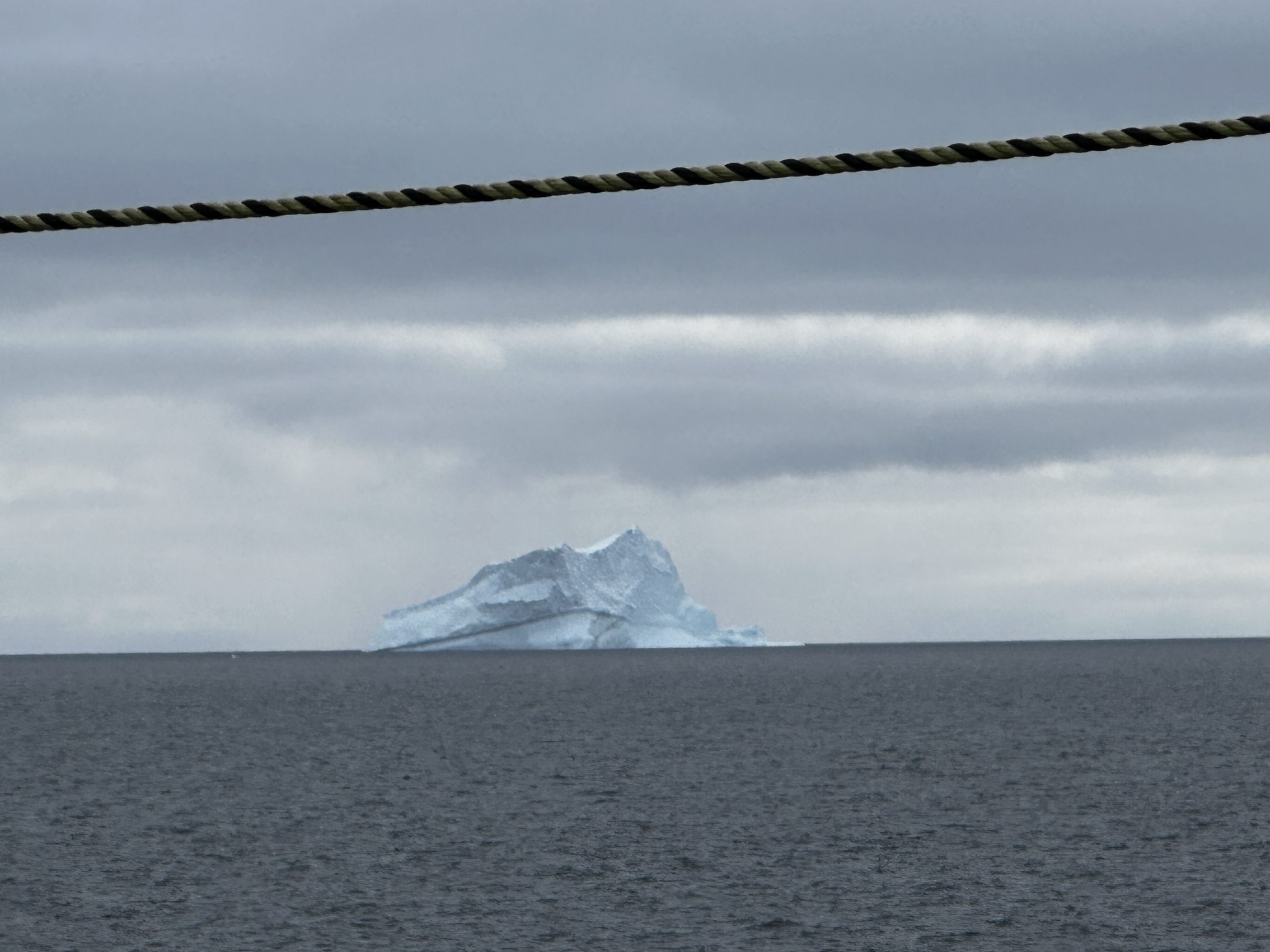4.2 Navigation

To navigate JOIDES Resolution in and out of port cities and during its transit to drilling sites, several tools were utilized to ensure the safety of the ship and those on board. Here, we touch on just a few of those critical resources that were necessary for ship navigation.
Paper Nautical Charts
You may be familiar with using the app Google Maps or a road atlas to find your way on land, but maps are not the same as nautical charts. A nautical chart assists mariners by providing information about water depth, navigation aids, the locations of underwater hazards, and more. All of these features are plotted with reference to latitude and longitude coordinates. Paper copies of nautical charts may seem “old school”, but the large paper copies are useful for several reasons. The Bridge crew utilize the charts for advanced planning over a larger geographic region and can be annotated during an expedition. Printed nautical charts are also essential to have as backup in case there were to be a disruption in ship’s power and the electronic navigation aids do not function.
Scroll through this image slideshow to see examples of the JR Bridge crew consulting paper copies of nautical charts in the Chart Room. This area with this chart table and the cabinet that stores the paper charts is right behind the bridge console on the Bridge.
Image 1: JR Captain and the Second Mate look over the charts and maps on the Bridge [IODP EXP 379]. Image 2: Third Mate studying the North Atlantic chart as we make our way through the waters around the Azores [IODP EXP 395E] . Image 3: Reviewing charts in the chart room [IODP EXP 328]. All images are from IODP JRSO, MerlinOne photo archive, CC BY 4.0)
This video clip is from the documentary North Pond: The Search for intraterrestrials (IODP Expedition 336) and provides an excellent example of the value of having paper copies of nautical charts on board.
Electronic Navigation Aids
The bridge console was filled with instrumentation to assist the crew in knowing their position, providing the ability to communicate, controlling the ship speed and direction, and more.

Click on the yellow circles with the plus symbol to learn the names and functions of the instrumentation.
Standing behind the bridge console (Credit: L. Guertin, IODP EXP 390)
Navigating in Icy Waters
Depending upon the time of year and the ocean basin for an IODP Expedition, JOIDES Resolution brought additional expertise on to the Bridge to assist with safe navigation around and within icy waters. When ice entered the picture, the two ice navigators on board were crucial to the expedition. From the Bridge, they monitored potentially hazardous ice movement, from the smaller “bergy bits” and “growlers” to massive icebergs. Ice navigators applied their extensive knowledge of ice physics, polar geography, navigation techniques, and maritime regulations in icy waters.
SciOD Spotlight – Victor Gronmyr: An IODP Expedition 400 Ice Navigator

How did you become an ice navigator?
I am a retired Canadian Coast Guard Captain, with 33 years of Coast Guard service. I was fortunate enough to spend many seasons in the Canadian Arctic understudying experienced Coast Guard captains. Eventually, I got to be a captain of an icebreaker myself. I’m in my 17th season working in polar waters and am an ice navigator with Martech Polar Consulting. I confer regularly with the principal consultant, Captain Duke Snider, my mentor of over 30 years, as well as dozens of colleagues via the company’s WhatsApp Channel (a social media communications tool).
What do Ice Navigators do?
One of our primary functions is to help the captain, ship’s officers and crew avoid dangerous hard ice.
Simply put – We don’t dent ships!
While navigating in the polar waters of Greenland we need to be aware of both sea ice and glacial ice. Expedition 400’s nearshore location for this time of the year in Baffin Bay means that glacial ice is the biggest concern. From the moment the Greenland glaciers calve into icebergs, they disintegrate until they completely melt. This breaking apart is also referred to as calving, or what I call “sharding,” and produces smaller icebergs, “bergy bits” and “growlers.”
What makes bergy bits and growlers unique?
Glacial ice is incredibly hard – it is like reinforced concrete. Bergy bits are glacial ice with heights of 1 to 5 meters above the sea surface. Growlers have heights of 0 to 1 meter above the water’s surface and 4 to 9 meters below. Both can, and will sink ships. Their low height in the water makes growlers very hard to sight. The only sure-fire method is visually, by eye.
What other types of tools do you use as an ice navigator?
Ice charts, satellite imagery, marine radar and ice radar, and our own eyes. There are many visual aids that I use: Polarized sunglasses, binoculars, searchlights and FLIR. FLIR stands for “Forward Looking Infrared.” They are essentially binoculars with a temperature sensor. They are easy to use and are very reliable.
How does FLIR work?
FLIR is a thermal device that picks up on infrared waves emitted by an object. The primary source of infrared radiation is heat or thermal radiation. The warmer the object, the more infrared radiation it emits.
Infrared is completely invisible to the unaided human eye. With FLIR you can adjust the visual settings. My favorite presentation is to have black as hot and white as cold. The super cold iceberg whose core temperature is about -15 degrees Celsius shows really well as bright white against the relatively warm salt water, which at 2 degrees Celsius shows as gray-to-black.
How is FLIR different from night vision?
They operate in different ways. Night vision devices amplify existing light so they need light to work, but not too much. They work best in the dark or in low light by enhancing the traces of visible light. On the other hand, thermal imaging as done by FLIR requires no light to work. FLIR works in complete darkness, full daylight or rapidly changing light levels. For over a decade, oil tankers traveling in Greenlandic polar waters have been experimenting with FLIR. FLIR allows the ships to detect ice day or night from a distance so collisions can be avoided.
Are there any drawbacks to FLIR?
FLIR cannot see past glass, so during Expedition 400, ice navigators must leave the warmth and comfort of the Bridge and go outside with the FLIR binoculars to make observations. Here’s a case where night vision is more flexible. It can see past glass as it is enhancing the visible light.

I have to ask, what was the size of the iceberg that sunk the Titanic?
Estimates of the iceberg would put it into the medium category, the peak rising approximately 30 meters above the surface of the ocean and a length of about 120 meters. A 1976 United States Coast Guard study on icebergs in Iceberg Alley of Davis Strait (between mid-western Greenland and Baffin Island) found that icebergs have a height to draft ratio of approximately 1 to 3.95. The draft is the depth below the water line. With this methodology, the Titanic’s iceberg was roughly 120 meters deep below the surface of the water. The same study provided a way to estimate the iceberg’s mass which would suggest that the Titanic’s iceberg would have contained approximately 1.3 million metric tons of ice, or about 2.8 billion pounds.
Expedition 400 has also kept company with some big icebergs!
Yes, we’ve moved away from some a few times. For about two weeks, we were in the vicinity of what is classified as a “Very Large Iceberg.” We affectionately called it “Fred.” As we retrieved cores, Fred veered as close as 3.5 nautical miles, then out to about 20 nautical miles. This happened a few times before we moved on to the next site. Fred was pointy on top, classified as “pinnacle shaped,” and was about 140 meters above the surface of the water by about 310 meters in length. Fred’s mass would be in the neighborhood of 40 million metric tons.
Icebergs may be enigmatic and formidable, but with skilled ice navigators assisting the captain and his team, Arctic expeditions can continue to uncover the secrets of the world’s polar regions while staying safe.
Interview conducted in 2023 by Beth Doyle, Onboard Outreach Officer for IODP EXP 400
Exercise : Questions From the SciOD Spotlight
a) Why can smaller icebergs, known as “bergy bits” and “growlers,” be more dangerous to a vessel than the larger ones?
b) FLIR, forward looking infrared binoculars, pick up on the heat emitted from an object. Features that are cold, like an iceberg will be white, while hot items will be black. If you were an ice navigator using FLIR to look out over the sea, what shade of color do you think a white seagull would appear to have?
View this video to learn more about the role of an ice navigator and the additional navigation tools used on IODP Expedition 400 (NW Greenland Glaciated Margin, August 12 -October 13, 2023).
Sometimes, additional assistance would be required from another ship to ensure safe operations at sea. See this article below that discusses how another ship came to help JOIDES Resolution stay on location and not have to navigate off site.
Example – International cooperation in Antarctic waters
This column from 1987 in MÆRSK POST describes one instance of international cooperation at sea to ensure safe ship operations. *Note that the ship Sedco/BP 471 referred to in this article was built in 1978 in Halifax, Nova Scotia. In 1984, it was converted into the floating scientific research laboratory JOIDES Resolution, but the ship was referred to by its prior name here.
On Tuesday, February 13, we received a laconic message from the Captain of the MÆRSK MASTER:
drill site W-5 saved.
drilling resumed.
Sedco/BP 471 very pleased.
Behind the message lies a story of excellent seamanship, which is well worth the telling.
As most readers will know, our newest offshore vessel, the MÆRSK MASTER, is on charter to Texas A&M University, which is conducting a scientific drilling programme in the Wedell Sea near the Antarctic.
The drill ship JOIDES Resolution has been chartered to do the actual drilling, and right now she is working at a position about 1200 nautical miles south-east of the Straits of Magellan, only about 300 nautical miles north of the Antarctic.
Early that Tuesday morning the “red alarm” was sounded on board the drill ship. A huge iceberg was closing in on the ship. The MÆRSK MASTER went into action and ran a hawser round the iceberg, which was thought to be 300 meters long and 250 meters wide and towering about 40 meters above sea level. A tow-line was attached, and the iceberg was pulled away from the drill ship at a speed of 400 meters per hour. The operation lasted 13 hours, in a gale, with gusts up to hurricane force and occasional heavy snow. The ship reported the estimated weight of the iceberg to be about 12 million tons.
No mean feat – and one which will create respect for our name. The captain and his crew deserve high praise for an effort in the best A.P. Møller tradition.
This column was authored by Mærsk Mc-Kinney Møller and appeared in MÆRSK POST, Volume 26, No. 1, March 1987 (reproduction permitted with acknowledgement of source).

